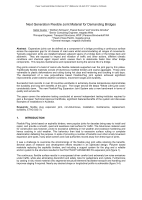Bridges

- Publication no: ABC2017-049-17
- Published: 21 April 2017
- PDF (free) Download
Expansions joints can be defined as a component of a bridge providing a continuous surface across the expansion gap for all classes of road users whilst accommodating all ranges of movements. Typically expansion joints are installed between adjacent spans of a bridge deck or the bridge deck and abutment. They are exposed to impact and vibration of traffic and other actions, different climatic conditions and chemical agent impact which causes them to deteriorate faster than other bridge components. This requires maintenance and replacement during the service life of a bridge.
Plug joints consist of a band of cast-in-situ flexible materials supported over the joint gap by thin plates. Traditionally flexible materials consist of bituminous modified binders and coarse aggregate. Those were vulnerable to plastic deformations and rutting during hot days and hardening and cracking in cold days. The development of a new polyurethane based Flexible-Plug joint system achieved significant improvements under extreme weather conditions, movement ranges and durability.
Successful track records in over 20 countries worldwide in extremely diverse temperatures demonstrates the durability and long term benefits of this joint. The longer service life keeps “Whole Life-Cycle costs” considerably down. The new Flexible-Plug Expansion Joint System sets a new benchmark in terms of quality and service life.
This paper covers the extensive testing conducted at several independent testing-institutes required to gain a European Technical Approval Certificate, significant features/benefits of the system and discusses examples of installations in Australia.
